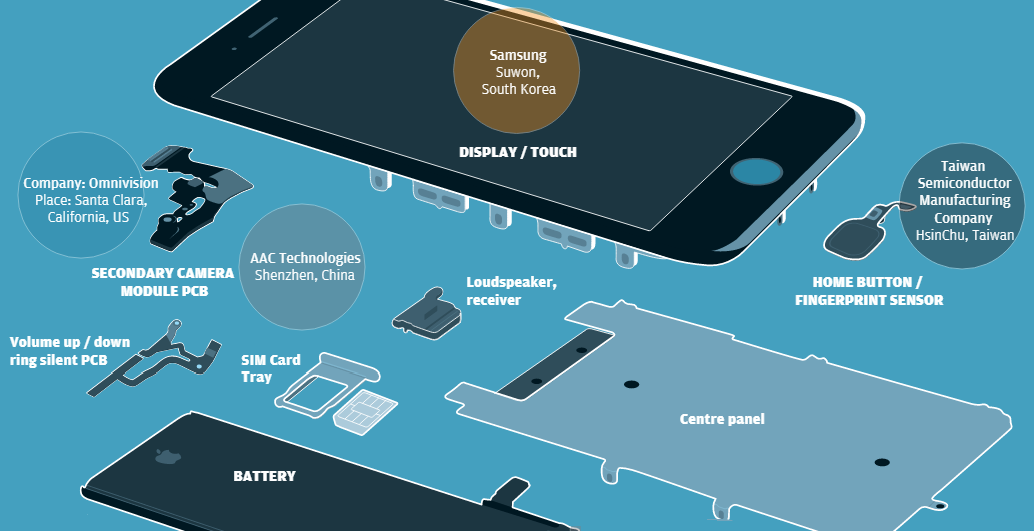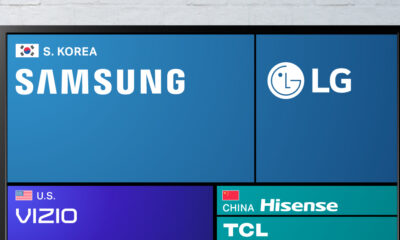Technology
See Every Single Part Inside an iPhone

See Every Single Part Inside an iPhone
In the past, we’ve broken down the extraordinary raw materials in an iPhone 6s, but today’s infographic takes it a step further: it delves into each individual component inside an iPhone as well as where it comes from.
Unfortunately, the data is not for the latest and greatest iPhone 7, which was only introduced last week. That said, it is still interesting to dive into the components and the manufacturers that make the 6s work.
What’s inside an iPhone?
The infographic comes to us from SCMP, and in total it highlights 34 individual components in an iPhone 6s. These parts range from German accelerometers to camera modules from Sony in Japan. Parts come from a range of eight countries, which include the United States, China, Taiwan, South Korea, Japan, Germany, the Netherlands, and the UK.
Many people will be likely surprised to learn that there are key pieces in the iPhone that come from Apple’s biggest competitor. At least some of the Apple A9 chips are manufactured by Samsung, but the South Korean company also produces display screens, mobile DRAM, and flash memory for Apple’s various devices. The ongoing relationship between the companies makes Apple the biggest external customer for Samsung’s components in the world.
Also interesting is that the manufacturing of physical pieces of bigger hardware (battery, screen, camera, etc.) tends to be dominated by Asian suppliers, while the technologies integrated with the printed circuit board mostly come from U.S. and European suppliers.
Technology for the iPhone 6s lithium-ion battery, for example, comes from three companies all in Asia. Two are based in China (Desay Battery Tech, and Sunwoda Electronics), while the other is located in Taiwan (Simple Technology).
Meanwhile, the following technologies from Texas Instruments in the United States integrate right into the printed circuit board: battery charger, power management, and the LED backlight Retina display driver. For another example, Bosch Sensortec out of Germany also provides two parts built into the circuit board: a barometer and an accelerometer.
Technology
All of the Grants Given by the U.S. CHIPS Act
Intel, TSMC, and more have received billions in subsidies from the U.S. CHIPS Act in 2024.

All of the Grants Given by the U.S. CHIPS Act
This was originally posted on our Voronoi app. Download the app for free on iOS or Android and discover incredible data-driven charts from a variety of trusted sources.
This visualization shows which companies are receiving grants from the U.S. CHIPS Act, as of April 25, 2024. The CHIPS Act is a federal statute signed into law by President Joe Biden that authorizes $280 billion in new funding to boost domestic research and manufacturing of semiconductors.
The grant amounts visualized in this graphic are intended to accelerate the production of semiconductor fabrication plants (fabs) across the United States.
Data and Company Highlights
The figures we used to create this graphic were collected from a variety of public news sources. The Semiconductor Industry Association (SIA) also maintains a tracker for CHIPS Act recipients, though at the time of writing it does not have the latest details for Micron.
| Company | Federal Grant Amount | Anticipated Investment From Company |
|---|---|---|
| 🇺🇸 Intel | $8,500,000,000 | $100,000,000,000 |
| 🇹🇼 TSMC | $6,600,000,000 | $65,000,000,000 |
| 🇰🇷 Samsung | $6,400,000,000 | $45,000,000,000 |
| 🇺🇸 Micron | $6,100,000,000 | $50,000,000,000 |
| 🇺🇸 GlobalFoundries | $1,500,000,000 | $12,000,000,000 |
| 🇺🇸 Microchip | $162,000,000 | N/A |
| 🇬🇧 BAE Systems | $35,000,000 | N/A |
BAE Systems was not included in the graphic due to size limitations
Intel’s Massive Plans
Intel is receiving the largest share of the pie, with $8.5 billion in grants (plus an additional $11 billion in government loans). This grant accounts for 22% of the CHIPS Act’s total subsidies for chip production.
From Intel’s side, the company is expected to invest $100 billion to construct new fabs in Arizona and Ohio, while modernizing and/or expanding existing fabs in Oregon and New Mexico. Intel could also claim another $25 billion in credits through the U.S. Treasury Department’s Investment Tax Credit.
TSMC Expands its U.S. Presence
TSMC, the world’s largest semiconductor foundry company, is receiving a hefty $6.6 billion to construct a new chip plant with three fabs in Arizona. The Taiwanese chipmaker is expected to invest $65 billion into the project.
The plant’s first fab will be up and running in the first half of 2025, leveraging 4 nm (nanometer) technology. According to TrendForce, the other fabs will produce chips on more advanced 3 nm and 2 nm processes.
The Latest Grant Goes to Micron
Micron, the only U.S.-based manufacturer of memory chips, is set to receive $6.1 billion in grants to support its plans of investing $50 billion through 2030. This investment will be used to construct new fabs in Idaho and New York.
-

 Education1 week ago
Education1 week agoHow Hard Is It to Get Into an Ivy League School?
-

 Technology2 weeks ago
Technology2 weeks agoRanked: Semiconductor Companies by Industry Revenue Share
-

 Markets2 weeks ago
Markets2 weeks agoRanked: The World’s Top Flight Routes, by Revenue
-

 Demographics2 weeks ago
Demographics2 weeks agoPopulation Projections: The World’s 6 Largest Countries in 2075
-

 Markets2 weeks ago
Markets2 weeks agoThe Top 10 States by Real GDP Growth in 2023
-

 Demographics2 weeks ago
Demographics2 weeks agoThe Smallest Gender Wage Gaps in OECD Countries
-

 Economy2 weeks ago
Economy2 weeks agoWhere U.S. Inflation Hit the Hardest in March 2024
-

 Environment2 weeks ago
Environment2 weeks agoTop Countries By Forest Growth Since 2001












